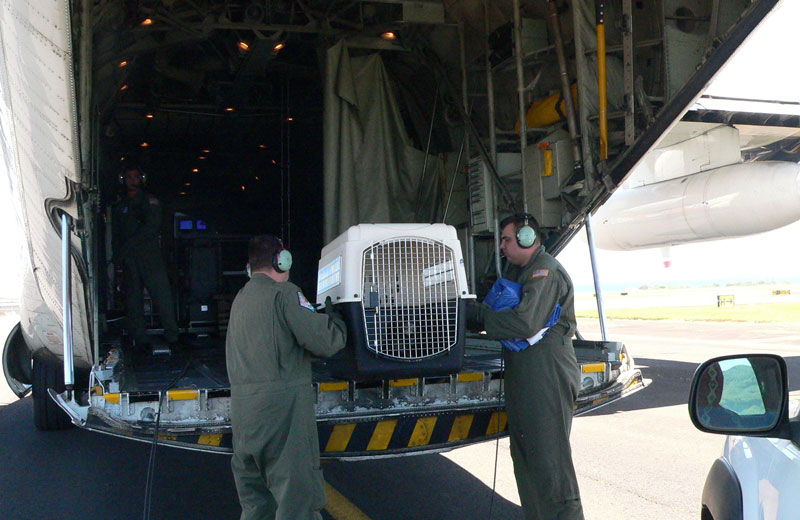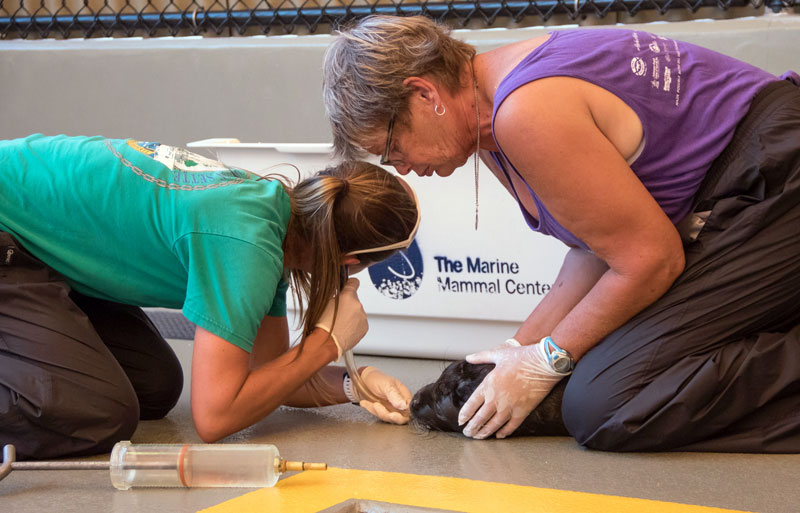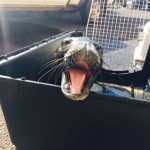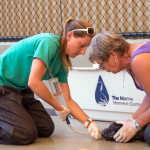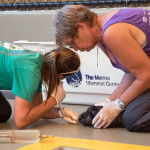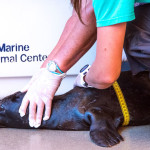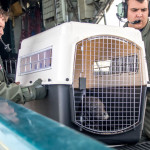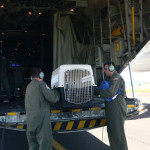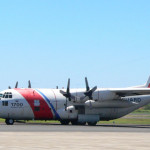On Monday a young female Hawaiian monk seal pup was found abandoned during a NOAA monk seal survey of Ni’ihau Island. The pup was emaciated and would certainly have died without intervention. A plan was devised to transport the seal to Ke Kai Ola, a monk seal rehabilitation facility in Kailua-Kona operated by The Marine Mammal Center. The Robinson family, who own Ni’ihau, and Ni’ihau Ranch staff were supporting the monk seal survey and helped with the first critical step by transporting the young pup to Kauai via helicopter.
This pup—named Kilo, which means “sassy” in Hawaiian—is the first monk seal from the main Hawaiian Islands that The Marine Mammal Center has admitted to Ke Kai Ola. “As we mark the first year of our work at Ke Kai Ola, we reach a significant milestone with the care of this pup,” said Dr. Jeff Boehm, executive director of The Marine Mammal Center. “Our vision for Ke Kai Ola is to care for Hawaiian monk seals in need from throughout the archipelago, and we’re prepared to provide the best medical care possible for Kilo. With each patient we treat and return to the wild, we take a step towards the recovery of this species.”
Once on Kauai, Dr. Michelle Barbieri, a veterinarian for the NOAA Hawaiian Monk Seal Research Program and The Marine Mammal Center, assessed the pup and worked to stabilize it.
“It’s a really good thing that the team was there to find this seal. She was in dire need of supportive care and would not have made it much longer in the wild,” said Barbieri. The pup was severely dehydrated, malnourished and likely anemic, but still showed a remarkable amount of energy. The first action was to start rehydrating the seal while finalizing transport plans.
NOAA contacted the U.S. Coast Guard to request air transport assistance on Monday afternoon. The HC-130 Hercules airplane crew from Coast Guard Air Station Barbers Point, Oahu, received the seal at Lihue Airport and transported them to the Kona International Airport, Kailua-Kona, Tuesday afternoon.
Safeguarding marine mammals falls under the Coast Guard’s living marine resources mission, one of the service’s 11 statutory missions. The nation’s waterways and their ecosystems are vital to the country’s economy and health. This includes ensuring the country’s marine protected species are provided the protection necessary to help their populations recover to healthy, sustainable levels.
Once at Ke Kai Ola, the pup was weighed, measured and given a full physical examination. Veterinary staff and trained volunteers gave the pup electrolytes through a stomach tube, and will continue to do so 4 to 5 times daily. “The tube feedings will start to include blended whole fish in the next 24 hours, as this pup is in dire need of calories. But we have to get her rehydrated first,” says Deb Wickham, Operations Manager at Ke Kai Ola. Blood samples will be collected and analyzed tomorrow. The pup is in guarded condition but experts are optimistic that she will be able to make a full recovery and be released into the wild in a few months.
In its first year of operations, Ke Kai Ola has rehabilitated eight young monk seals from the Northwestern Hawaiian Islands. Six have been successfully returned to the wild and the remaining two will be headed home this weekend. Kilo is the first patient from the main Hawaiian Islands to come into the hospital for rehabilitation.
There are currently about 1,100 monk seals left in Hawaii and each individual female seal is important to help ensure the future of the species. NOAA Fisheries is the lead for monk seal recovery efforts, but it is a network of partners that makes much of their mission successful.
“The compassion and support for monk seals shown by the Robinson family and Ni’ihau residents in transporting the seal from Ni’ihau; the rapid response by the Coast Guard to get the seal to urgently needed care; and the careful rehabilitation by The Marine Mammal Center, all were necessary to give this young seal a real chance for survival,” David Schofield, NOAA’s Regional Marine Mammal Response Program Coordinator, says. “And in turn they give the many pups she could have the chance to help save this critically endangered species from extinction.”
Photo Gallery (Click to enlarge)
- Kilo awaits transport by the U.S. Coast Guard from Lihue Airport in Kauai to Kona International Airport, Kailua-Kona, where she will be rehabilitated at The Marine Mammal Center’s hospital, Ke Kai Ola. Credit Michelle Barbieri © The Marine Mammal Center, HMSRP Permit 16632
- Kilo, which means “sassy” in Hawaiian, is tube fed electrolytes by veterinary staff and trained volunteers at The Marine Mammal Center’s Ke Kai Ola Hawaiian Monk Seal hospital. The female Hawaiian monk seal pup was found abandoned during a NOAA monk seal survey of Ni’ihau Island. Credit © The Marine Mammal Center, MMHSRP Permit 18786
- Veterinary staff from The Marine Mammal Center (Michelle Barbieri, left, and Deb Wickham, right) tube-feed Kilo to ensure she gets the nutrition she needs. Credit Julie Steelman © The Marine Mammal Center, MMHSRP Permit 18786
- Kilo rests at her new temporary home at Ke Kai Ola, The Marine Mammal Center’s hospital for the critically endangered Hawaiian monk seal. Credit Julie Steelman © The Marine Mammal Center, MMHSRP Permit 18786
- Members of the U.S. Coast Guard at Lihue Airport lift Kilo onboard a transport aircraft before flying to Kona International Airport, Kailua-Kona. Credit Julie Steelman © The Marine Mammal Center, HMSRP Permit 1663
- Personnel from the U.S. Coast Guard at Lihue Airport load Kilo onboard a plane before flying to Kona International Airport, Kailua-Kona. Credit Mimi Olry © The Marine Mammal Center, HMSRP Permit 16632
- he U.S. Coast Guard aircraft that transported Kilo is seen getting ready to take off from Lihue Airport to Kona International Airport, Kailua-Kona, with Kilo onboard. Credit Mimi Olry © The Marine Mammal Center, HMSRP Permit 16632


